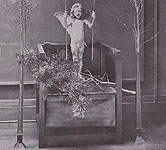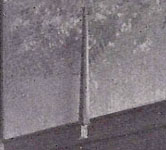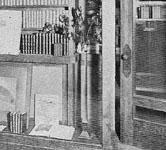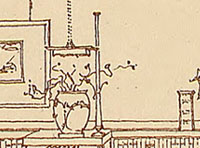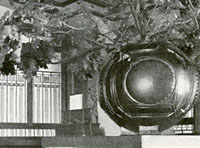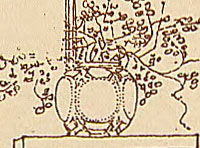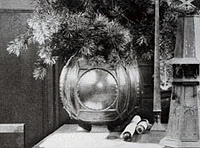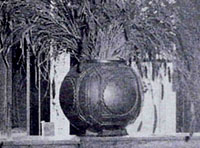|
|
WRIGHT STUDY
Browne's
Bookstore, Chicago (1907 - S.141) |
|
|
|
Copper "Weed
Holder" designed by Frank Lloyd Wright |
|
|
|
|
|
Wright began experimenting with
variations for designs of Weed Holders and Urns as early as 1894,
"Monograph 1887-1901" Pfeiffer, 1991, pages 60-61.
John Lloyd right wrote "Not satisfied with the
bric-a-brac of the day, Father designed his own. The copper
weed-holders pictured to the right and left of the chair are
his early creations. Father liked weeds!"
"My Father Who
is on Earth", 1946, page 24. Examples of the Weed Holder are
not as plentiful as those of the Copper Urn. |
|
It was one of Wright's
favorite objects. He included it in a number of drawings and
projects he worked on, including his own
Home and Studio, the
Dana house and
Browne's Bookstore. By 1925, one
was photographed in the Taliesin III Living Room,
"Nature of Materials",
Hitchcock, 1942, Plate 273.
In 1910 Frank Lloyd Wright
produced the "Ausgeführte
Bauten und Entwürfe von Frank Lloyd Wright" (S.87),
published by Ernst Wasmuth, in Berlin. While Wright
included... Continue... |
|
|
|
|
|
|
|
|
|
|
|
|
|
|
|
"Copper
Urn" designed by Frank Lloyd Wright |
|
|
|
|
|
Wright began experimenting with
variations of the design for the Urn as early as 1894, and the
design of the first designed this copper urn in the late 1890's,
"Monograph 1887-1901" Pfeiffer, 1991, pages 60-61.
It was one of Wright's favorite objects. He included it in a
number of drawings and projects he worked on, including
those for the Edward C. Waller house,
Wright's own Home and Studio, the
Dana house,
the Coonley house,
Browne's Bookstore and appeared in
an early image of Unity Temple. |
|
Eighteen inches tall, and
according to Hanks, "Decorative
Designs" 1979, p70-1, it was
executed by James A. Miller and Brother.
In 1910 Frank Lloyd Wright
produced the "Ausgeführte
Bauten und Entwürfe von Frank Lloyd Wright" (S.87),
published by Ernst Wasmuth, in Berlin. Wright included the
Copper Urn in three Wasmuth plates.
A) Browne's Bookstore
Plate
XXXVI (36). B) Coonley
Plate LVI
(56). C) Coonley
Plate LVIb (56b).
The copper urn appears in two...
Continue... |
|
|
|
|
|
|
|
|
|
|
|
|
|
|
|
|
|
|
|
Browne's
Bookstore Side Chair
designed by Frank Lloyd Wright |
|
|
|
|
|
On December 8, 2002,
John Toomey Gallery, Oak Park, auctioned three
Side Chairs in the position of Unity Temple.
According to Toomey Gallery, "the
chairs had been in the collection of Unity
Temple of Oak Park, Illinois, Wright’s first
public commission. It was presumed that the
chairs were donated to the Temple following the
demolition of Browne’s Bookstore. They are the
only known examples from that commission that
have ever been offered for sale." Of note is the
below chair on the right (1b). No original
photographs have been found that show this chair
with the |
|
"double horizontal molded rail". Could
it possibly have been an office chair?
In 1910 Frank Lloyd Wright
produced the "Ausgeführte
Bauten und Entwürfe von Frank Lloyd Wright" (S.87),
published by Ernst Wasmuth, in Berlin. Browne's Bookstore
appeared in as the bottom half of
Plate
XXXVI. Although it was published two years after the
completion of the bookstore, minor details changed from the
actual bookstore. Sixteen Side Chairs are included in this
illustration. |
|
|
|
|
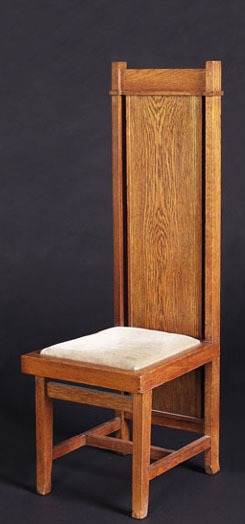 |
|
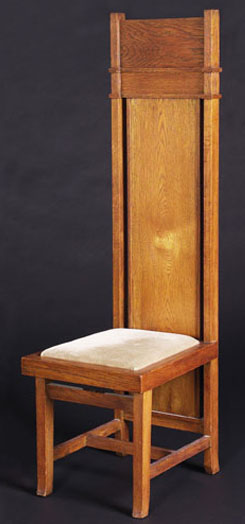 |
|
1a: Two Browne's Bookstore
Side Chairs. Wide slat under a single
horizontal rail, refinished, 15”w x
18.5”d x 48”h. Courtesy of the
John Toomey Gallery. |
|
1b:
One Browne's Bookstore Side Chair. Wide
vertical paneled slat at back under a
double horizontal molded rail, original
drop in seat, refinished, 15.5”w x
18.5”d x 54”h. Courtesy of the
John Toomey Gallery. |
|
| |
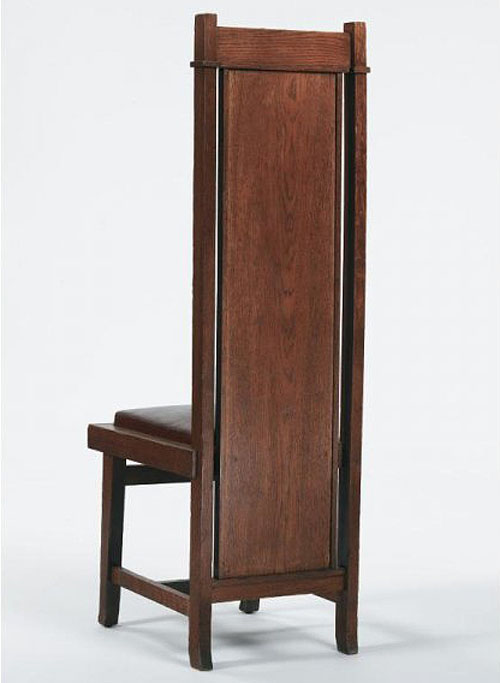 |
|
1c:
Side Chair. Sold at Sotheby's on
December 5, 2005 for $22,800. Oak with leather upholstery 47
5/8 inches high. Courtesy of Sotheby's. |
| |
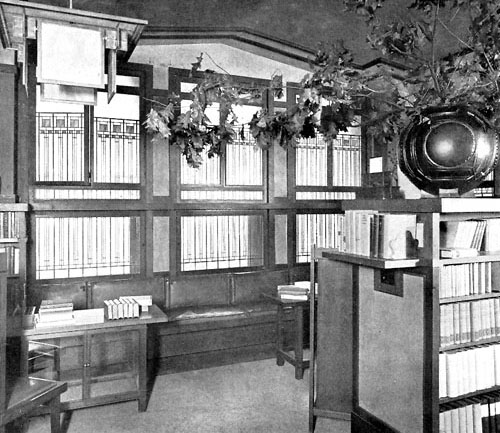 |
|
2: Browne's Bookstore 1908. View of
front Cove. Two Side Chairs are visible in the
image, one on the far left, one right of center. |
|
|
|
Int5 |
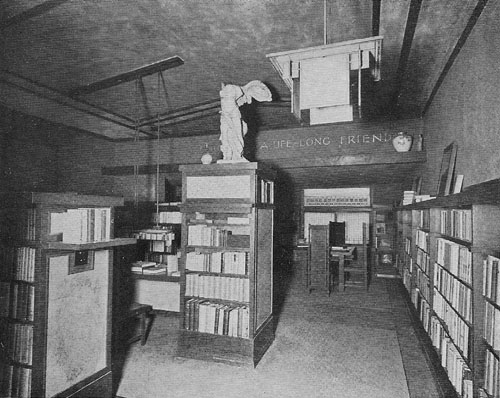 |
|
3a: View from entry
to back. Four Side Chairs are visible in this
image. One on the left in the alcove, and three
at the table right of center. See detail below. |
|
Int6 |
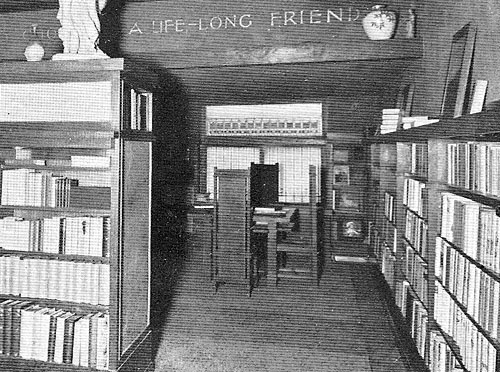 |
|
3b: Detail of the View from
entry to back. Three Side Chairs are visible, arranged
around the table. |
|
|
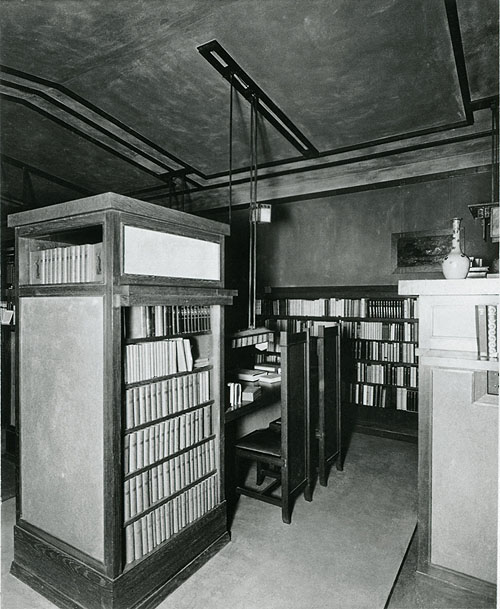 |
|
4: View of
Cove. Each Cove included a built in table and four
high-backed Side Chairs. Two are visible. |
|
|
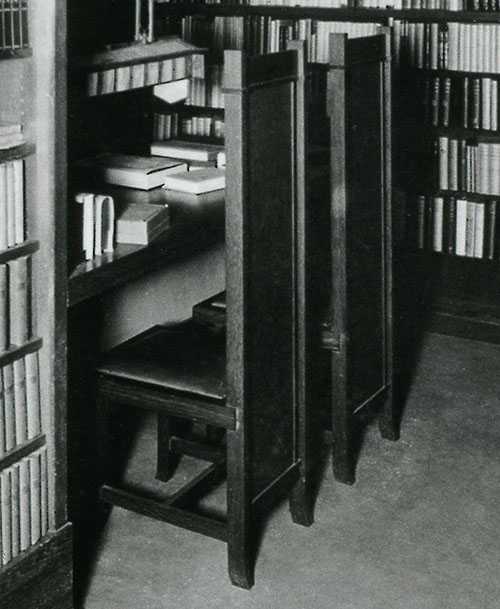 |
|
4a: Detail of Side
Chairs. Each Cove included a built in table and four
high-backed Side Chairs. |
|
|
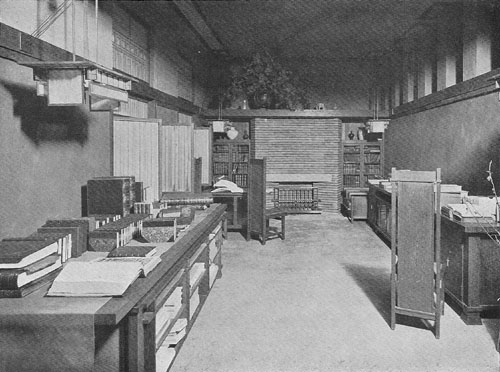 |
|
5: View toward
fireplace. Three Side Chairs are visible in this
image. Two in he center, toward the back, and one on
the right in the right foreground. |
|
|
 |
|
Int35a:
This detailed illustration of Browne's Bookstore
appeared in 1910 as the bottom half of
Plate
XXXVI. Although it was published two years
after the completion of the bookstore, minor
details changed from the actual bookstore.
Sixteen Side Chairs are included in this
illustration. |
|
|
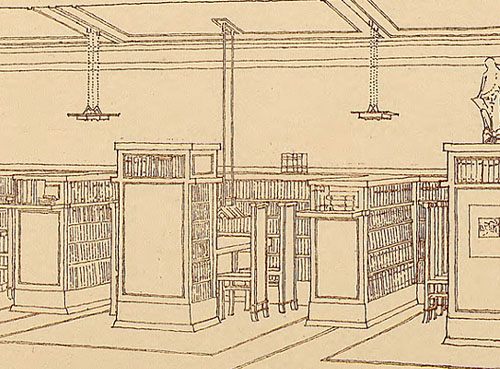 |
| 5b: Detail
of the center alcove. Each alcove included four Side Chairs. |
| |
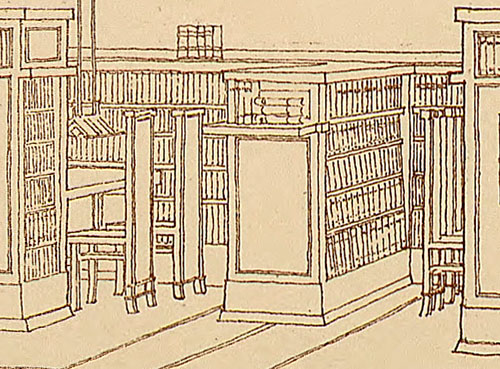 |
| 5c: Detail
of the center (left) and fourth (right) alcoves. Each alcove
included four Side Chairs. |
| |
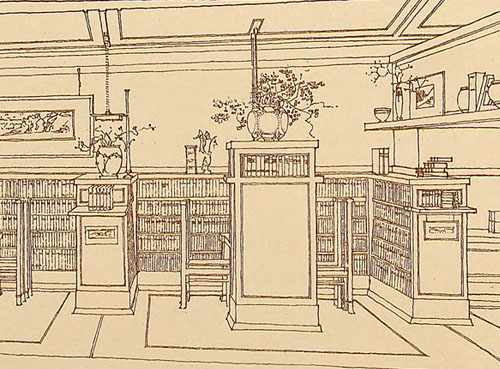 |
| |
| 5d: There
were a total of five identical coves, this being the last
one on the right. Each alcove included four Side Chairs.. |
| |
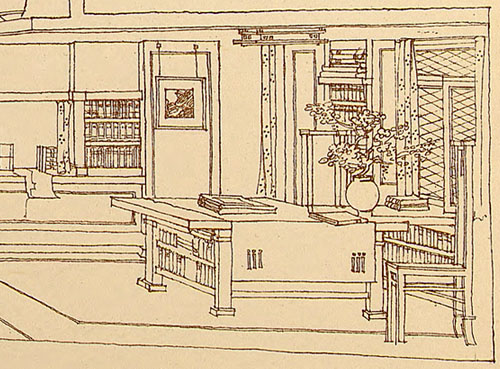 |
| 5e:
Detail of the far right side of Plate XXXVI. A single Side
Chair is included with the display table. |
| |
| |
| |
|
|
|
Winged Victory Statue |
|
|
|
|
|
The Winged Victory Statue was a
favorite design element that Wright included in many of the
projects that he worked on. The Winged Victory of
Samothrace, also called the Nike of Samothrace, is a second
century BC marble sculpture of the Greek goddess Nike
(Victory). Since 1884, it has been prominently displayed at
the Louvre and is one of the most celebrated |
|
sculptures in the
world.
Besides Wright's own home, it
could be found in the Browne's Bookstore, the Larkin
Administration Building, the Darwin Martin home
conservatory, the Robie House and the Little Residence.
Monograph
1, plate 401 shows a recent photograph including the
Winged Victory Statue. |
|
|
|
|
 |
|
1: Browne's
Bookstore. View from entry to back. Alcoves were
arranged along the left side. Wright
adorned the top of a book shelf with his
familiar Winged Victory Statue and quotations on
the wall. |
|
OP4a |
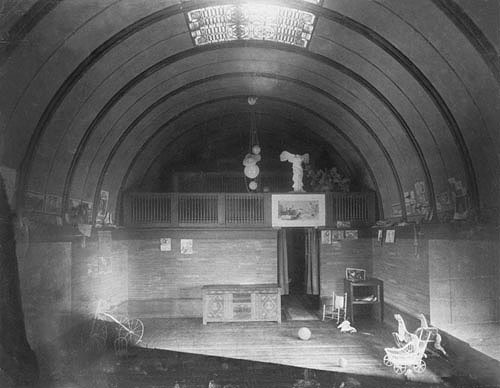 |
|
2a: Wright's
Oak Park Playroom, Circa 1900. The
Winged Victory
Statue is above the doorway. Very similar image published in
"Architectural
Review" June 1900, p65. |
|
|
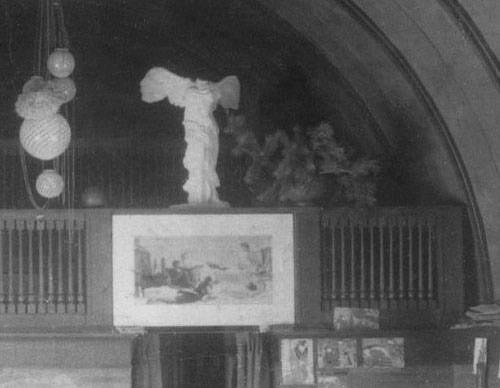 |
|
2b:
Detail of Wright's Oak Park Playroom, Circa 1900.
Winged Victory
Statue is above the doorway. |
|
|
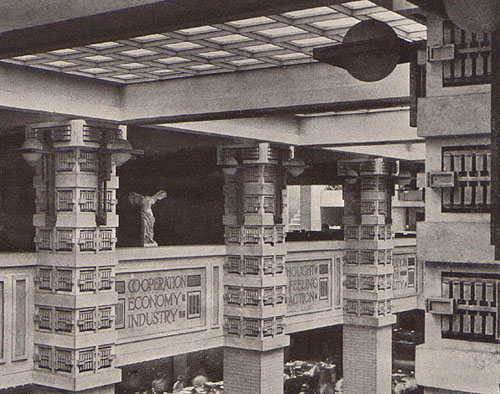 |
|
3: Larkin Co.
Administration Building (1903 - S.093), Circa 1904-08.
The
Winged Victory
Statue is visible center left.
Published in "Frank
Lloyd Wright, Ausgeführte
Bauten"
1911, page 132. |
| |
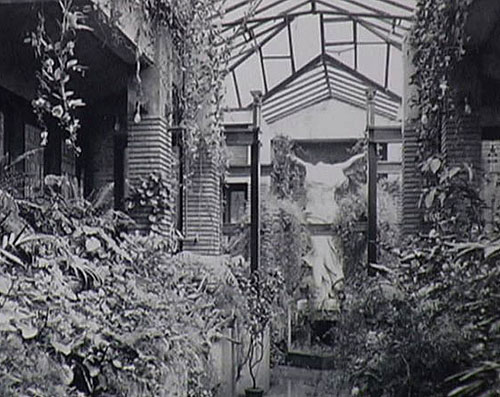 |
|
4: Darwin
D. Martin Residence Conservatory (1904 - S.101). This large
version of the Winged Victory
Statue became the center piece of the conservatory. |
| |
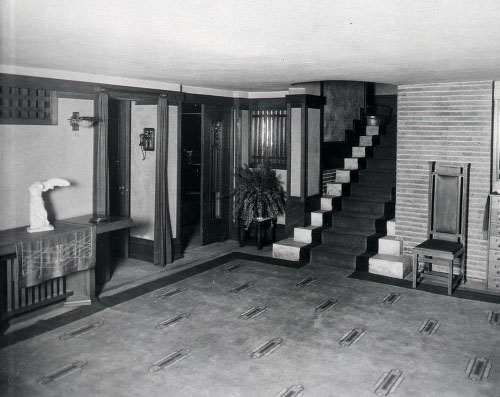 |
|
5:
Frederick C. Robie Residence Entrance Hall (1906 - S.127).
This small version of the Winged Victory
Statue adorned a table in the Entrance Hall of he Robie
House. Courtesy of the Frank Lloyd Wright Preservation
Trust. |
| |
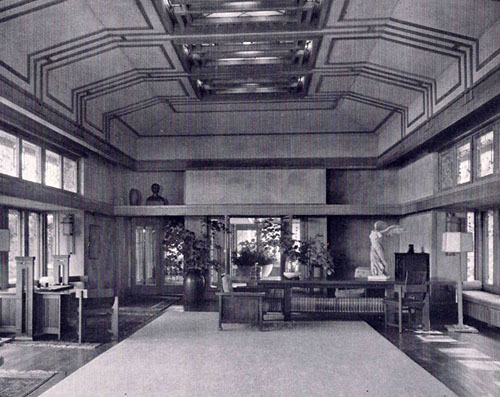 |
|
Francis W.
Little Residence
Living
Room (1912 - S.173).
The
Winged Victory
Statue sits atop a table in the Little Living
Room.
Additional information about this image. |
|
|
|
|
|
Statue of David |
|
|
|
|
|
Michelangelo created the Statue
of David in 1504, and today is housed in the
Gallery of the Accademia di Belle Arti in Florance, Italy.
Like the Winged Victory, Wright placed the Statue of David
in a few of his designs. The Dana House and Browne's
Bookstore. |
|
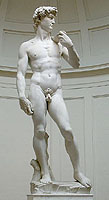 Actual
Statue of David in
Florance, Italy. Actual
Statue of David in
Florance, Italy. |
|
|
|
|
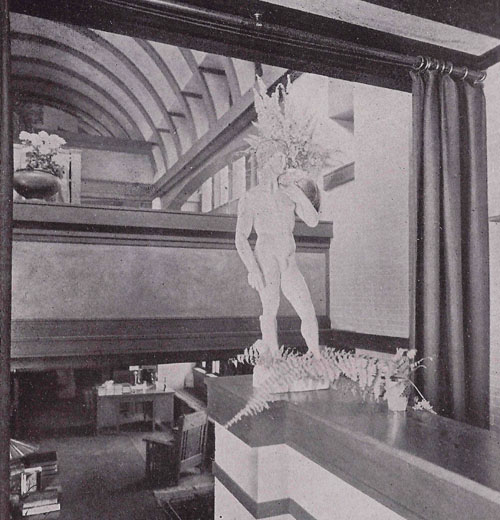 |
| 1:
Dana House 1902, View toward Library. Statue of David sits
atop stairway pedistal. Of note is the Wasmuth Plate XXXIb,
which is nearly an exact duplication of this view but minus
the Statue of David. |
| |
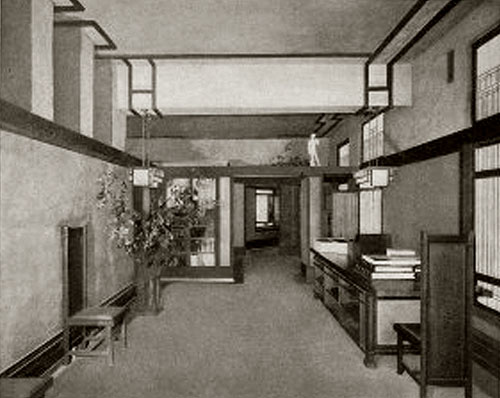 |
|
2: Browne's
Bookstore 1907-8. View from the
fireplace, back room. Statue of David visible
above doorway. Published in
"A Notable
Bookstore". |
| |
| |
|
|
Back |
|
|
|
|
|
|

CLICK TO ORDER
Actual Statue of David in Florance, Italy.
